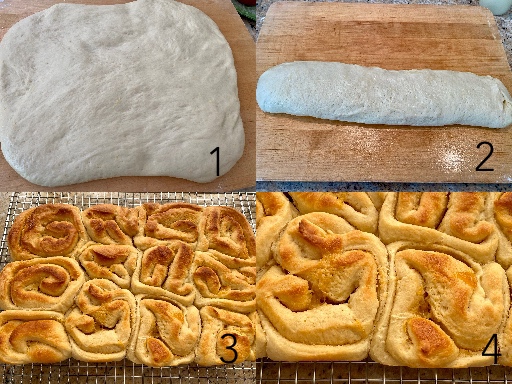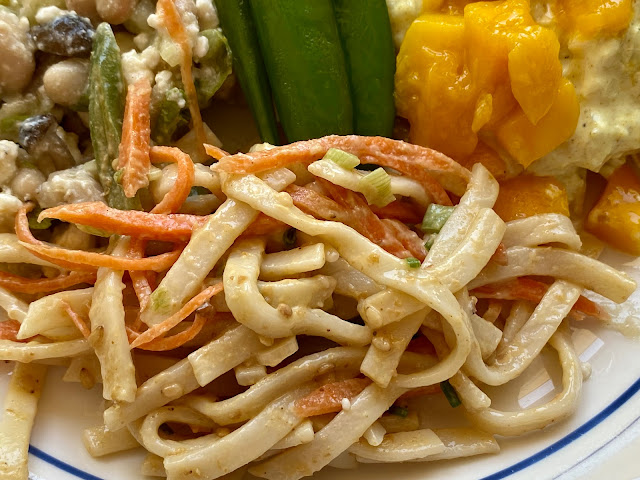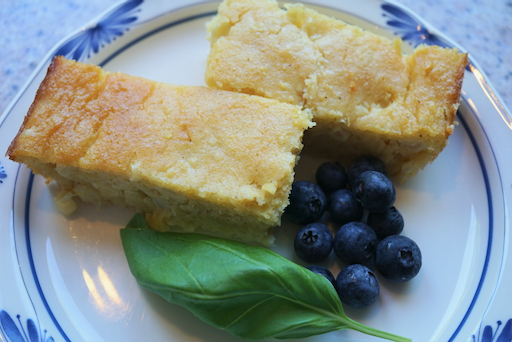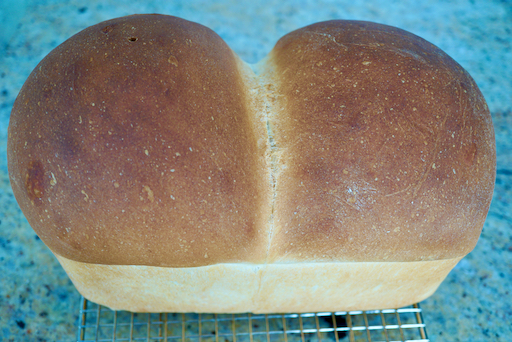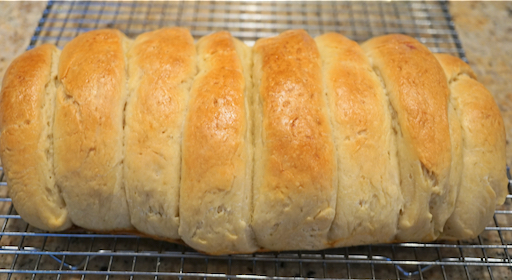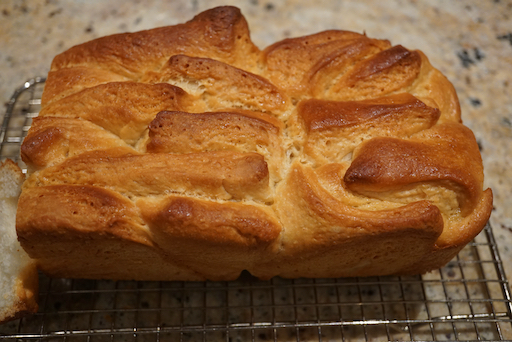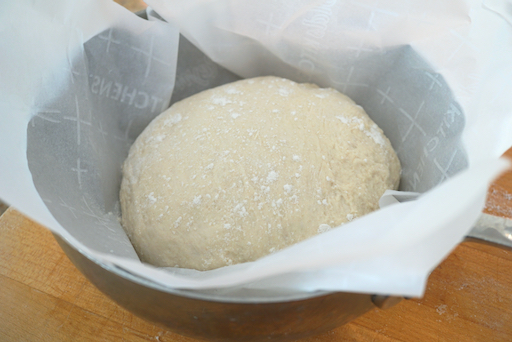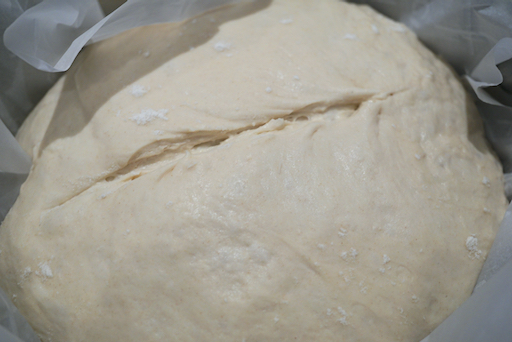Wednesday, December 17, 2025
Chili Crisp Cottage Cheese Flatbread カッテージチーズフラットブッレドと食べるラー油
*Spicy chili infused oil “辣油” is a traditional condiment in Chinese cuisine. In Japan, it is known as “ra-yu ラー油”. Chili crisp or chili crunch is a variation chili oil in which bits of chili, garlic and other solids are included. This became very popular during the COVID time (2020 on) in the U.S. and many brands (including some U.S. brands) became readily available. In Japan, this was known as “eating ra-yu or 食べるラー油”.
**Japanese condiment maker “Momoya 桃屋” started selling a Japanese version of chili crips which was dubbed as “Looks spicy but not too spicy ra-yu 辛そうで辛くない 少し辛いラー油” in 2009 which was a big hit in Japan.
So my wife started making the bread but at the last moment her friend called and I was left to do the final preparation; making the dough balls, let them rest. Preheating the cast iron skillet. Pressing and stretching the dough balls in to 7 - 8 inch disks without making holes and cooking them in the cast iron skillet. The picture #1 is the result. I included the Japanese chili crisp in the picture (on the side).
This is how we enjoyed it (picture #2). Just dip the bread in the chili crisp. (We subsequently found that spreading the chili crisp directly on the bread works very well too.) The bread and chili crisps were wonderful. The fried garlic adds a nice crunch and the oil is flavorful but not hot; just a bit of buzz which suits us just fine. The bread on its own also has nice flavors.
Ingredients
3/4 cup (170g) cottage cheese, whole milk preferred
1/2 cup (114g) water, warm
2 1/2 teaspoons instant yeast
1 1/2 teaspoons granulated sugar
1 1/4 teaspoons table salt
1 cup (14g) cilantro, leaves and tender stems*
2 1/4 cups (270g) King Arthur Unbleached Bread Flour
1 tablespoon (22g) chili crisp, plus more for brushing
vegetable oil, for brushing or greasing
*Or substitute with dill, parsley, or a mix
Directions:
To make the dough: In a food processor, process the cottage cheese, water, yeast, sugar, and salt until smooth, 20 to 30 seconds. Add the cilantro, flour, and 1 tablespoon (22g) chili crisp, in that order, and process in about 8 to 10 second-long pulses, until the dough comes together and starts to gather around the blade.
Scrape the dough into a lightly greased bowl, cover, and let it rise until increased in volume by about 1 1/2 times, 30 to 45 minutes.
Transfer the dough to a lightly floured work surface and knead it gently, sprinkling with additional flour as necessary, until it's smooth, springy, and less sticky, 30 to 60 seconds. (The dough was extremely, wet and sticky and required the addition of a fair amount of flour to make it workable.)
Divide the dough into 4 pieces (about 150g each) and shape each into a tight ball. Cover with plastic wrap and set aside until puffy and relaxed, 15 to 30 minutes.
Toward the end of the rise time, preheat a large cast iron skillet over medium-high heat. Working with one dough ball at a time, stretch or roll into a 7" to 8" round. Brush the top with vegetable oil, then place, oil-side down, in the skillet. Cook until brown underneath and bubbled on top, 1 to 2 minutes. Brush the other side with oil then flip the dough and cook until brown on the second side, 1 to 2 minutes.
While one flatbread is cooking, shape the next.
For an extra spicy finish, brush the warm flatbreads with chili crisp before serving.
Friday, February 21, 2025
Assorted Japanese Mini-pans 日本のミニ菓子パン各種
Sunday, February 11, 2024
Sweet Onion Bread Pudding 玉ねぎのブレッドプディング
The recipe came from “Southern living”.
Ingredients: Recipe X 1/2
1 tablespoon butter
2 cups chopped Vidalia onions
1 cups fresh bread cubes (crusts removed)
6 oz. evaporated milk
2 large eggs, lightly beaten
3/4 cups shredded Parmesan cheese (or combination of other cheeses)
1/2 teaspoon salt
Ingredients (Original recipe)
2 tablespoons butter
4 cups chopped Vidalia onions
2 cups fresh bread cubes (crusts removed)
1 (12-oz.) can evaporated milk
3 large eggs, lightly beaten
1 1/4 cups shredded Parmesan cheese (or combination of other cheeses)
1 teaspoon salt
Directions
Melt butter in a large skillet over medium heat; add chopped onion, and sauté 10 to 15 minutes or until tender.
Place onion and bread cubes in a large bowl. Stir in milk, eggs, 1 cup cheese, and salt. Pour into a lightly greased soufflé or baking dish. (For 1/2 recipe I used the smallest pyrex baking dish). Sprinkle with remaining 1/4 cup cheese.
Bake at 350 ̊ for 25 minutes or until set.
This is basically an onion flavored bread pudding. It is very flavorful (and very rich). Initially the onion was quite strong. It got better with time as the onion flavor blended into the cheese and bread. The 1/2 recipe was perfect for us.
Wednesday, May 31, 2023
Mango Chutney Almond Milk Rolls マンゴーチャツネとアーモンドミルクロール
Ingredients:
For the dough
3 1/2 cups flour, plus more as needed for rolling the dough
1/4 cup granulated sugar
1 tsp. Salt
2 1/4 yeast
2 1/2 cups almond milk (not sure why almond milk is required next time I’ll just use regular milk)
4 Tbs. Salted butter
1 egg
For the filling:
30-50 grams sweetened condensed milk
30 grams butter softened
2 tsp sugar
3 Tbs. Major Grey’s mango chutney
Directions:
Add the dry ingredients; flour through yeast to the bowl of a stand mixer fitted with a dough hook. Add the wet ingredients; almond milk through egg. Mix until smooth dough forms. Knead for 10 minutes. Turn out onto floured surface and shape into a loaf. Put in a bowl, coat the surface with vegetable oil. Cover and put in the dough proofer at 78 degrees until doubled in size. Punch down the dough. Cover and let rest for 10 minutes.
Meanwhile make the filling by mixing together the ingredients for the filling. Roll out the dough into a large rectangle (#1). Cover the rectangle with the filling then roll it up as tightly as possible without squeezing out the filling (#2). Cut the roll into 14 to 16 equal slices. Put the slices cut edge down in a greased pyrex cooking dish. (Note: it is rather hard to cut the slices; they tend to squish. Out of frustration I just made the last part of the dough into a loaf and cooked it on a small cookie sheet. (I did not take a picture of this.) The loaf turned out just fine and could be cut into slices after it was baked. I might do this in the future instead of trying to make the rolls. ) Bake in a 375 degree oven for 20 to 25 minutes until golden brown (#3, #4).
These muffins were quite good. The dough had a crunchy crust but a soft interior. The filling formed a light custard like texture which was slightly sweet but with a lovely hint of spice from the chutney. Several large pieces of mango from the chutney provide a moist surprise burst of flavor. These were perfect flavorful pastries to have for breakfast with coffee.
Friday, May 12, 2023
Cheese Stuffed Romanian Flat Bread チーズ入りのルーマニアのパン
The bread looks a bit overdone but it tasted ok with a toasty flavor, crispy crust and the soft cheesy center. Despite some difficulties, I have to say this was a sucess.
As usual, my wife deviated from the original recipe.
Ingredients:
2 1/2 cups (313 grams) all-purpose flour, plus more as needed
2 tablespoons granulated sugar
2 1/4 teaspoons (7 grams) quick-acting or instant dry yeast
1 pinch fine salt
6 tablespoons sunflower oil or other neutral oil
1/3 + 1/2 cup milk
Filling
6 oz. Ricotta cheese (this is what my wife used)
3 Tbs. Honey
1/8 Tsp. Cayenne pepper
1/4 Tsp. Salt
6 ounces farmers cheese or cottage cheese (if using cottage cheese hang shortly in a cheese cloth to drain excess liquid).
Optional:
Honey, for drizzling
Flaky sea salt, for sprinkling (optional)
Directions:
Put the flour, yeast, salt, sugar in the bowl of a stand mixer with a dough hook. Add the oil to the milk and stir into the dry ingredients. If the mixture seems dry, add cool water, 1 teaspoon at a time; if it seems tacky, add a little more flour. Knead the dough until soft and smooth, about 10 minutes. (Cover the bowl with a clean, damp cloth and let the dough rise at room temperature for 1 hour, or until almost doubled in size. (Alternatively, cover and refrigerate the dough overnight.)
Lightly flour the work surface and turn the dough out onto it. Divide the dough into 6 equal pieces. Working with one piece at a time, roll the dough into a 10- to 12-inch-wide circle. Crumble or spread a sixth of the cheese, about 1 ounce (28 grams), in the center, leaving a 5-inch border around the cheese. Fold the sides of the round into the center in 7 to 8 folds, overlapping them slightly. The dough should cover the cheese. Then press the filled circle of dough with your hands or use a rolling pin to gently press the bread closed. Repeat with the remaining dough and cheese.
In a large, cast-iron skillet (or if you can’t find it any non-stick frying pan will do) over medium heat, heat 1 tablespoon of the oil until it shimmers. Swirl the pan so the oil coats the bottom and place one of the dough rounds in the pan. Fry until golden brown on the bottom, 2 to 4 minutes, then flip and cook until golden brown on the other side, another 2 to 4 minutes, adjusting the heat as needed. Transfer to a plate and cook the remaining dough rounds, adding more oil as needed.
Serve warm, with honey and flaky salt, if desired.
In the picture it looks like these became a bit “high-done” but they were nicely crunchy and had a toasty flavor. The mildly sweet and creamy ricotta cheese filling was lovely with the finely textured bread. These opened all kinds of possibilities for potential variations…think ham and cheese.
Monday, May 1, 2023
Four Salad Lunch 4種類サラダランチ
The picture below shows Israeli couscous with artichoke hearts and garbanzo beans with a nice lemony and dill dressing.
The pic below shows a celery, mushroom, and navy bean salad with feta cheese. The mushrooms make the salad. They gave an almost meaty texture and flavor.
The next is a curry flavored sous vide chicken salad. Since we had a nice ripe Champagne mango, I added small cubes of mango which went very well with this salad.
I made this udon noodle salad since I had left-over cooked udon noodles. The dressing is sesame-flavored. I do make several versions of the sesame dressing (for example, using Japanese “nerigoma” ねりごま sesame paste or peanut butter) but this time I used Tahini with dry roasted white sesame seeds which I ground in a Japanese “suribachi” すり鉢 mortar. Other seasonings included soy sauce, sugar, and rice vinegar.
This was a surprisingly filling lunch. Beans, udon noodles, and couscous all contribute to this and, at the same time, we enjoyed so many different flavors and textures. We just have to make sure we finish all these salads before they go bad.
Thursday, January 27, 2022
Breakfast croissant casserole クロワッサンキャセロール
One day my wife decided to make this croissant casserole dish she saw at an on-line recipe site. It is a cross between quiche and French toast but closer to a crustless quiche. It is the usual milk, egg, and cheese mixture but instead of a pie crust or regular bread this dish uses croissants. Although this was entitled "breakfast croissant casserole", we had this as a lunch with cucumber tomato salad.
She cut the recipe in half and used small store bought croissants. This is a good quiche-like breakfast dish but I was not too crazy about it especially knowing how much bacon, egg and cheese went in. I will let my wife to provide the ingredients and directions.
Ingredients: This is a reduced recipe amount because we weren't feeding a crowd)
4 strips of bacon (crisped and then crumbled)
2 onions chopped
3 eggs
1 cup whole milk
1 tsp. Dijon mustard
1/2 tsp salt
1 cup grated cheese (I used smoked gouda and cheddar)
3 croissants
Directions:
Crisp the bacon. Set aside. Using the bacon drippings saute the onions until slightly brown. Cool slightly. Mix the eggs, milk, Dijon, salt, crumbled bacon and cheese together. Arrange the croissants in the baking dish. Pour the liquid egg mixture over the croissants making sure they are submerged. Cover and put in the refrigerator overnight. The next morning cook in a 375 degree oven for 30 minutes until golden brown. (I used the small blue pyrex baking dish and cooked it in the toaster oven).
This turned out to be an entirely ho-hum form of savory bread pudding. The croissants seemed to dissolve into the pudding like egg mixture which contributed to the quiche like consistency. Don't get me wrong it was quite good and makes an interesting egg alternative to an omelet.
Thursday, August 26, 2021
Butter, butter, butter, butter, rolls バター、バター、バターロール

2 1/4 cups unbleached AP flour
2 tsp. Salt
2 1/4 tsp. Yeast
1 cup warm water (recipe calls for water 130 degrees F. I thought that was too hot and would kill the yeast. I don’t know what the purpose of such a high temperature would be.)
1 cup (two sticks) of butter softened for 20 minutes to room temperature
Directions:
Put the flour, salt, and yeast in the bowl of stand mixer. Add the water and mix until the ingredients are combined then beat for 4 minutes. Cover the bowl and let the dough rest for 15 minutes. Cut the butter into 1/4 inch slices. Pat and roll the dough into a 10 X 8 inch rectangle about 1/2 inch thick. Distribute the 1/2 of the butter pieces on the rectangle (picture on the left below). Using a spatula spread the butter evenly over the dough leaving a 1 inch border all around. With the long edge facing you fold the dough over into thirds and pinch the edges tightly to seal. (The dough should now measure 3 X 8.) Roll the dough out into a 12 X 6 rectangle. Distribute the remaining butter over the rectangle. Again using a spatula spread the butter evenly over the dough rectangle leaving a 1 inch border all around. With the short side facing you fold the dough into thirds pinching the sides to seal tightly. Let the dough rest 5 minutes.
Line baking sheet with 1 inch sides with parchment paper. Gently roll the dough into a 10 x 8 rectangle. Using a sharp knife (I used a pizza cutter), cut the dough into 2 inch squares. Place the squares on the baking sheet one inch apart, cover and let rolls rise for about 30 minutes. (They will not rise much but will soft and puffy). Bake in a 400 degree oven for about 20 to 25 minutes until golden brown (picture on the right). (Some of the butter will leak out so they will be baking in bubbling butter).
Let cool about 10 minutes then serve.
Sunday, July 18, 2021
Corn pudding (bread/cake ?) コーンプディング/ケーキ
2 cups of corn (1 cup to puree, 1 cup raw corn = 3/4 cup puree) (1 cup to add whole to the batter). Cooked and removed from the cob. There is flexibility in the amount of puree you use. See 2X below)
1/2 tsp. salt
1/4 tsp. cayenne pepper or to taste
3/4 cup (180 g.) sour cream (or 3/4 cup ricotta cheese results in a firmer cake. We prefer this texure) or (1/2 cup sour cream and 1/4 cup ricotta cheese this results in a softer cake; more like a mixture between pudding and cake)
2 large eggs
1 1/2 Tbs. (20 g,) granulated sugar
2 1/4 Tsp. baking powder
7 Tbs. (55 g.) AP flour
6 Tbs. (55 g.) cornmeal
Ingredients X2
2 cups of pureed corn (I made this with 1 cup of puree. Because I miscalculated and that was all I had and it came out just fine)
1 tsp. salt
1/2 tsp. cayenne pepper or to taste
1 1/2 cup (360 g.) sour cream (or 1 1/2 cup ricotta cheese results in a firmer cake. We prefer this texure) or (1 cup ricotta and 1/2 cup sour cream this results in a softer cake; more like a mixture between pudding and cake)
4 large eggs
3 Tbs. (40 g,) granulated sugar
2 1/2 Tsp. baking powder
(use medium sized pyrex baking dish)
Directions:
Take 1 cup of the corn and puree it in a food blender and set aside. (if you are not going to use the corn right away heat it to boiling in a pan to kill any potential bacteria. )Brown the butter in a sauce pan. Reserve 2 Tbs. of the browned butter and set aside (to be put on the pudding once it is cooked). Mix the pureed corn, whole corn, butter, salt, pepper and sour cream together. Let cool. Once cooled whisk in the eggs. Then the baking powder, flour and cornmeal. Pour mixture into a greased 6 X 10 inch pyrex baking dish. Cook in a 350 degree oven for 40 to 45 minutes until a cake tester comes out clean. Pour the reserved Tbs. of browned butter over the top.
With all the butter, sour cream and eggs this is not the most dietetic dish but it sure is good. It is more like a moist corn bread (cake?) than a pudding. The sweet corn flavor permeates. The whole corn gives a nice crunch and an additional burst of corn sweetness. Hard not to eat the whole thing in one sitting.
Saturday, April 10, 2021
Japanese milk bread with cream cheese クリームチーズで作った日本風ミルクパン
This is an addition to the on-going saga of my wife making Japanese-style milk bread. As a gift, we received several large hard cover cookbooks; one was the “French Laundry Cookbook” and another was “Bouchon Bakery”. While browsing through the books my wife found a recipe called “Pain-au-Lait Pullman loaf”. Since she can read French fairly well, she immediately recognized this translated to “milk bread”. As she read the recipe, she found out it was indeed a Japanese style milk bread but they replaced the milk with cream cheese to make the crumb more moist. Although she thought she had already baked a full gambit of Japanese milk breads, she determined this was a variation she had not yet attempted and, besides, cream cheese is one of her favorite ingredients. So she went for it. The instructions were a bit unusual (read: incomprehensible. For example at one point it says, and this is a direct quote, “mix on low speed for 4 minutes. Continue to mix on low speed for 30 minutes” (huh??) Would that be 34 minutes of continuous mixing ?!!) So she consulted me and we decided to follow our CCK (Common Culinary Knowledge). In addition since we do not have “Pullman” bread pans, we made the bread using a regular loaf pan. It came out quite well as seen below. This is a close tie with the original milk bread I made. But a slightly different flavor due to the cream cheese. Lightly toasted with butter...perfect for breakfast with a cup of Cappuccino or Cafe latte.
Ingredients:
547 g. AP flour
1 3/4 tsp yeast
32 g. sugar
11 g. salt
285 g. water
35 g. egg (probably one small egg)
25 g. butter (cut into cubes)
79 g. cream cheese (cut into cubes)
Recipe doubled:
1094 g. AP flour
3 1/2 tsp yeast
64 g. sugar
2 tsp. salt
570 g. water (or milk)
2 eggs
50 g. butter (cut into cubes)
158 g. cream cheese (cut into cubes)
Put the dry ingredients in the bowl of a stand mixer with a dough hook. Mix the water and the eggs together. Slowly add the mixture to the dry ingredients until incorporated. Add the butter and cream cheese. Continue mixing until it is incorporated. Add additional flour as necessary to achieve a smooth dough. Continue kneading for 7 to 10 minutes. Put in a bowl. Coat with vegetable oil cover and put into a proofing box set at 81 degrees until doubled in size. Deflate the dough. Form into two balls and put touching together into a heavily greased loaf pan. Return to the proofing box and let rise until slightly higher than the rim of the loaf pan. Bake in a 375 degree oven for 25 to 30 minutes or until it sounds hollow when tapped. We also made this bread as a muffin (3 oz. in large pyrex). While the muffin is good we think it is better as a loaf of bread.
This was one of the best milk breads my wife made. The texture was very soft but moist. It had a nice rich flavor and although I couldn’t taste it, my wife claimed she could taste a hint of the cream cheese which made it different from the previous variations she made. Toasted with butter...as I said perfect!
Friday, March 26, 2021
Irish-style soda bread #3 アイルランド風ソーダブレッド #3
This is the third and last of my wife’s Irish soda bread baking binge. This one is quite different from the “traditional” recipe. This came from “Nancy Silverton’s Pastries from the La Brea Bakery”. It is much more complicated than the traditional recipe. (It wouldn’t be La Brea if it wasn’t). It is a muffins/roll and uses eggs, butter, sugar and Caraway seeds. This one is accordingly called “Irish-style”. As a result, it has a very different flavor from the traditional. (Although I used an Easter bunny plate for the picture, my wife pointed out that I covered up the “bunny’s” face with the bread when I took a picture below so only his feet are showing). (Sorry).
Ingredients
3 3/4 cups AP flour
1/2 cup whole wheat flour
1/4 cup sugar
1/2 cup wheat flakes (I didn’t have any so I left it out)
1 1/2 tsp. kosher salt
1 Tbs. baking powder
1 Tsp. baking soda
1 Tbs. lemon zest (or 2 tsp. lemon flavoring)
2 Tbs. caraway seeds
1/2 stick (2 oz.) butter cut into 1/2 inch cubes and frozen
1 3/4 cup buttermilk
Directions:
In a bowl whisk together the dry ingredients from the AP flour to the the caraway seeds so they are well distributed. In the bowl of a food processor with a steel blade add some of the mixed dry ingredients with the butter and pulse until it resembles fine meal. Add the rest of the mixed dry ingredients and continue pulsing. (I found this works better to fully incorporate the butter. If all the mixed dry ingredients are added at once the butter remains in cubes.) Put the dry mixture into a large bowl. Mix the buttermilk and egg. If using lemon flavoring add it to the buttermilk now. Mix the buttermilk egg mixture into the dry mixture. Mix just until everything is incorporated. (I found I had to add more buttermilk for the dough to form otherwise it would have been just crumbs and not held together). Turn out onto a floured surface and gently pat into it together. (The original recipe calls for patting it into a 1/2 inch thick rectangle and then cutting it into various shapes using about 1/2 cup of dough for each shape.) I just took a 1/2 cup measure. filled it with dough and turned it out onto a cookie sheet lined with parchment paper. Bake in a 375 degree oven for 35 to 40 minutes.
This was without a doubt the most complex and refined version of the Irish soda breads my wife made. It had depth of flavor. The caraway seed with the slight hint of lemon was a very good addition. It had the familiar rough crunchy crust and soft moist interior. Traditionalist would say, “but it is not genuine soda bread.” Next time my wife said she would make it even less so by adding raisins.
Tuesday, March 23, 2021
Irish soda bread #2 アイルランドソーダブレッド #2
After making one Irish soda bread, my wife is on a roll and made this Irish soda bread from her favorite bread recipe book “Beard on bread”. This one used whole wheat flour.
I will ask my wife to provide the recipe.
Ingredients:
3 cups whole wheat flour
1 cup AP flour
1 Tbs. kosher salt
1 tsp. baking soda
3/4 tsp. baking powder
1 1/2 to 2 cups buttermilk
Directions:
Combine the dry ingredients and mix thoroughly to distribute the soda and baking powder. Add enough buttermilk to make a soft dough. It will be the consistency of biscuit dough but should be firm enough to hold its shape. Knead for 1 or 2 minutes until smooth and velvety. Form into a loaf and place in an 8 inch pie pan well buttered or lined with parchment paper. Cut the traditional cross on the top of the loaf. Bake in a 375 degree oven for 35 to 40 minutes until golden brown and sounds hollow when tapped.
This was a nice variation on the Irish soda bread theme. The whole wheat flour gave it a slight nutty flavor. The texture was fairly dense but also moist. It tasted great slightly microwaved and slathered with butter.
Sunday, March 21, 2021
Traditional Irish soda bread 伝統的アイルランドソーダブレッド
Just a few days before St. Patrick’s day, I happened to see a “real Irish soda bread” recipe on the “Serious Eats” website. I showed my wife the recipe and in passing mentioned that St. Patrick’s day was coming up. Next thing I knew she has found 2 other Irish soda bread recipes and for 3 days in a row when I came home a new loaf was cooling on the rack. What a treat! This is the first loaf she made. It was baked in an enameled cast iron Dutch oven like “no-knead bread” and produced a nice brown crust and center was moist.
15 ounces all-purpose flour (3 cups; 425g)
1 3/4 teaspoons (7g) kosher salt; for table salt, use the same weight or half as much by volume
1 1/8 teaspoons (6g) baking soda
18 ounces low-fat cultured buttermilk (2 1/4 cups; 510g), well shaken
Directions
1.Adjust oven rack to middle position and preheat to 450°F (230°C) at least 15 minutes in advance. Roughly cover the bottom of a deep 10-inch cast iron or enameled Dutch oven with a sheet of parchment paper; no need to trim.
2.Combine flour, salt, and baking soda in a large bowl and whisk a full minute to combine. Stir in buttermilk with a flexible spatula until dough is fully moistened and no pockets of flour remain. For extra-fluffy results, stop folding as soon as dough comes together. For extra-chewy results, fold dough about 20 seconds more. Scrape sticky dough into prepared Dutch oven and smooth with a spatula into a rough boule-like shape. Score deeply into quarters with a sharp knife or razor, cleaning the blade between each slice.
3.Cover and bake until well risen and golden, 45 minutes. Remove lid and continue baking until chestnut brown, with an internal temperature of 210°F (99°C), 12 to 15 minutes longer. Invert onto a wire rack, discard parchment, turn right side up, and cool until crumb has set, about 30 minutes. Cut thick slices to accompany hearty soups and stews, or slice thinly for sandwiches. (This will be easier if bread is allowed to cool 2 hours more.) Store up to 24 hours in an airtight container and toast to freshen bread before serving.
The bread had a nice crunchy crust and the interior was moist with a nice crumb. The buttermilk gave it a subtle tang. The flavor was a bit salty. We had this with a lamb stew I made. (What else would you have for St. Patrick’s day?) This was the perfect bread to accompany the stew.
Our plum tree was in full bloom and our backyard was filled with the nice sweet smell of plum blossom. This is the plum tree we got many many years ago. We wanted the type of plum that produced the fruit used to make Japanese salted plum and umeshu. After some search, we finally found one at an Oregon nursery. It arrived as a twig in a small envelope but it miraculously grew into a good sized tree and provided lots of plum fruit over the years. We used the fruit to make “umeshu” plum wine. Then, a few years ago all the plum trees in the area got a fungal disease. Our poor tree was no exception. We thought it was a “goner” especially after we had to transplant it during a landscaping project. Although the tree is much smaller than it was at its peak, it appears that this plum tree is surviving. Spring is almost here.
Monday, March 15, 2021
Condensed milk bread V2 コンデンスミルクパン version2
This is yet another version of my wife’s exploration of Japanese milk bread. This version is made with both condensed milk and cake flour so you would expect it to be very soft and fluffy...It wasn’t.
Ingredients:
3.5 cups cake flour
1 Tbs. instant yeast
1/2 tsp. salt
3/4 cup whole milk at room temperature
3/4 cup condensed milk
1 egg
2 oz. butter
Egg wash
1 medium egg
1 Tbs. whole milk
Condensed milk glaze (I didn’t use)
3 Tbs. condensed milk
1 Tbs. butter.
Directions
Place the ingredients in a stand mixer with a dough hook. Mix until dough forms. Knead for 7 to 10 minutes. Form a ball. Put in a bowl. Coat with oil. Cover and put into proofing box until it doubles in size.
Deflate the dough and form into a cylinder that will fit in the load pan. Use a sharp knife and cut the cylinder into pieces of equal thickness. Place the pieces seam side down in the lightly greased loaf pan (shown in the picture below). Cover and let rise in the proofing box until double in size. Lightly brush the top of the loaf with the egg wash mixture. Cook in a 350 degree oven for 35 to 40 minutes until golden brown.

This bread came out hard and dry. The specified amount of cake flour did not result in a dough. The mixture was more like a batter. My wife had to add much more cake flour for it to take shape. We’re not sure what went wrong but this was a disappointment and will not be a regular on our baking schedule.
Friday, March 12, 2021
Condensed milk bread コンデンスミルクパン
My wife has been on a “roll” of making Japanese milk bread. She found many recipe variations on the internet and is trying a number of them. The picture below is one. The directions for making the bread that results in the irregular crust shown in the picture below seemed improbable. But it worked. The crust has a nice crunch and the bread itself is slightly sweet. An almost custard like filling forms in the grooves created by the irregular crust.
Ingredients:
for the dough
200 g of bread flour
20 g of sugar
3 g salt
3 g active yeast
30 g sweetened condensed milk
130 g warm milk
20 g butter
for the condensed milk filling
20 g sweetened condensed milk
20 g butter
Ingredients ( X 2)
for the dough
400 g of bread flour
40 g of sugar
6 g salt
6 g active yeast
60 g sweetened condensed milk
260 g warm milk
40 g butter
for the condensed milk filling
40 g sweetened condensed milk
40 g butter
600 g of bread flour
60 g of sugar
9 g salt
9 g active yeast
90 g sweetened condensed milk
390 g warm milk
60 g butter
for the condensed milk filling
60 g sweetened condensed milk
60 g butter
Directions
Add the ingredients to a stand mixer with a dough hook. Mix until a dough forms then continue kneading on low speed for 7 to 10 minutes. It is ok if some of the dough sticks to the bottom of the bowl as it is being kneaded. Turn dough out onto a board and do final hand kneading. Form into a ball. Coat with vegetable oil and put into a bowl. Cover and put into the proofing box until it doubles in size. While the dough is rising mix together the filling. by mixing the butter and condensed milk to form a smooth paste.
Once the dough is finished rising roll out into a rectangle. Evenly spread the filling over the dough (#1).
Cut the sheet into 4 even pieces (#2). Then, stack them on top of each other. Divide into 8 even pieces. Arrange each piece in a loaf pan (#3). Cover and put back into the proofing box until it doubles in size (#4). Bake in a 300 degree oven for about 35 minutes or until golden brown.
Sunday, February 21, 2021
"Almost" no-knead bread, improved version of no-knead bread ほとんど捏ねないパン改善版
Ingredients: (I am listing the original Kenji's recipe and metric weight in parenthesis which I converted by weighing the ingredients but not just numerical conversion of "cups" and "tsp", "tbs").
3 cup (425g) AP flour (Instead of bread flour, this recipe uses AP flour, I am not sure why but I should try it with bread flour).
3/4 cup plus 2 tbs (207g) water
6 tbs (80g) beer*
1 tbs (13g) white distilled vinegar (I used rice vinegar)
(Total liquid of 290g which makes hydration rate of 68%)
1 1/2 tsp salt
1/4 tsp instant yeast
*Kenji recommends to use light Pilsner-style lager beer such as Budweiser. I did not have Bud in our fridge so I used Sam Adams' Boston lager.<
Directions:
In a bowl, mix the ingredients using a wood spoon until no dry flour remains.
Take the dough out and put on a floured board and knead 10-15 times. Make into a boule-shaped dough ball.
Place the dough in a parchment paper lined skillet (below picture. Kenji's recipe include spraying with vegetable spray but I do not see the need for that and skipped that process).
Place this uncovered in the proofing box (the box has a water tray providing moisture to prevent a skin from forming on the dough). Let it rise for the second time for 1-2 hours.
Bake for 30 minutes with the lid on and 5-10 minutes more minutes with lid off.
Thursday, February 18, 2021
Milk bread with condensed milk and tangzong コンデンスミルクと湯種のパン
for the tangzong
20 g (2 Tbs. + 1 tsp.) AP flour
for the dough
115 g (1/2 cup) whole milk
12 g (1 Tbs. sugar)
5 g (1 1/2 tsp yeast)
320 g (2 2/3 cups AP flour)
3 g (1 tsp. salt)
60 g (3 Tbs.) sweetened condensed milk (I have used up to 90g of condensed milk which worked just fine.)
1 large egg
55 g (4 Tbs. butter, melted)
egg wash (optional)
1 large egg
1 Tbs. whole milk
Directions:
for the Tangzhong: whisk the flour and milk together in a sauce pan. Heat until it thickens. Set aside and let cool.
for the dough: Warm the milk and add the sugar. Cool to 110 F and use it to bloom the yeast. In a stand mixer combine the flour and salt. Add the condensed milk, egg, melter butter, tangzhong and yeast mixture. Mix until a dough forms. Knead for 7 to 10 minutes. Shape to dough into a ball. Add to a bowl and coat with a thin coating of oil. Put bowl in a warm place (we used the proofing box) until doubled in size. Punch dough down. Shape into a loaf and put into a greased bread loaf pan. Back into the proofing box until doubled in size. If using the egg wash, mix the egg and the milk then brush over the loaf. Cook in a preheated 350 degree oven for 28 to 30 minutes until it is golden brown and sounds hollow when tapped. Let cool on a wire rack.
The main difference between this bread and previous versions was the texture. It was still very light but there appeared to be a lot more holes. It was still very soft and moist. It almost melted on the tongue. It also didn’t rise as much as the previous versions. It had a buttery slightly sweet flavor. This was still a wonderful bread lightly toasted and buttered.
Friday, February 12, 2021
Perfectly pillowy cinnamon rolls 完璧に柔らかなシナモンロール
This recipe is from King-Arthur flour. The recipe was on a card that was enclosed with the collapsible bread proofing box we recently bought from them. This recipe piqued my wife's interest because it is made with "tangzhong" 湯種 and, of course, because it is a "sweet" bread. So she made this one day. She also added raisins but omitted the icing called for in the original recipe.
Ingredients:
for the Tangzhong
1/2 cup (113 g ) whole milk
3 Tbs. (23 g) bread flour
2/3 cup (151 g) cold whole milk
2 1/2 cups (300 g) bread flour
1 tsp. salt
2 Tbs. (25 g) sugar
2 tsp. yeast
4 Tbs. (57 g) butter softened
1 cup raisins or nuts (optional)
for the filling
1 Tbs. (14 g) butter, melted
1/2 cup (107 g) light brown sugar, packed (amount reduced slightly or increased to taste)
2 Tbs. (15 g) bread flour
4 tsp. (10 g) cinnamon
pinch of salt
For the icing (optional) I did not use it.
3 Tbs. (42 g) butter melted, divided
1/2 tsp. vanilla
1 1/2 cup (170 g) confectioners sugar, sifted
1 to 2 Tbs. (14 g to 28 g) milk
Directions:
For the tangxhong: in a small saucepan, whisk together the milk and flour and cook over medium heat until thickened. Transfer to a large bowl.
For the dough: Immediately add the dough ingredients to the bowl with the tangzhong in the order listed. (The order is important because the cold milk cools the tangzhong to the right temperature for the yeast). Mix and knead to make a smooth, elastic, somewhat tacky dough. Knead for 7 - 10 minutes. Put in a bowl and move to the proofing box set to 81 degrees until the dough rises and is puffy.
To assemble: Transfer the dough to a lightly greased work surface and pat into a 10 X 12 inch rectangle. Stir together the filling ingredients and sprinkle over the dough, leaving a 1/2 inch strip uncovered on one of the long sides. Distribute the raisins or nuts over the filling. Starting with the filling covered long side, roll the dough into a log. Slice into 12 slices. Put the pieces on a parchment lined baking sheet spaced about 2 inches apart. Tuck the tails underneath each roll to keep them from unravelling as they rise. Back into the warmer until they about double.
Bake on a rack in the upper third of a preheated 375 degree oven for 14 to 18 minutes until light golden brown. Remove from the oven and brush with 1 1/2 Tbs. of melted butter.
For the Icing (optional): Mix the remaining 1 1/2 Tbs. (21 g) melted butter with the remaining icing ingredients. Ice the rolls while they are just lukewarm.
These rolls have just the right amount of sweetness and the butter cinnamon mixture is very nice. While they were baking and when they were lightly microwaved before serving the yeasty cinnamon aroma was one of the pleasures of these rolls.
Saturday, February 6, 2021
"Kuri-mu pan" Cream custard buns クリームパン
Ingredients:
for the custard:
2 large eggs + 1 egg yolk
70 g sugar (1/3 cup)
15 g corns starch (2 Tbs.)
20 g cake flour (2 Tbs.)
300 g milk (1 1/4 cup)
1 tsp. vanilla
1 Tbs. butter
for the dough
250 g bread flour (2 cups)
50 g cake flour (1/3 cup)
30 g sugar (2 Tbs.)
20 g sweetened condensed milk (1 Tbs +1 tsp)
80 g cream (1/3 cup)
80 g milk (1/3 cup)
1 tsp. yeast
1/2 tsp. salt
30 g cold butter cut into small cubes (2 Tbs.)
Directions:
For the custard
In a bowl, mix eggs, sugar, corn starch and cake flour until well combined. Heat milk in a sauce pan until steaming. Temper the egg mixture with the hot milk by adding several ladles full slowly and stirring to combine. After the egg mixture is tempered add it to the milk still in the sauce pan. Cook on medium low heat until it starts to thicken, stirring constantly. This could take some time so be patient. When it achieves a fairly firm consistency (i.e. won't run off if placed on a flat piece of dough). Take it off the heat. Add the butter until melted and then stir in the vanilla. Continue whisking so it doesn't form a skin as it cools. After it cools slightly cover with plastic wrap touching the top of the custard, again so it doesn't form a skin as it cools. Set aside or put into the refrigerator to use later.
For the dough
Add everything from the bread flour to the yeast into a stand mixer. Mix until dough forms. Let it rest for 30 minutes. Add the salt and knead for 1 minute. Add the butter a piece at a time kneading the dough until smooth. Knead 7 to 10 minutes. Form into a ball in a greased bowl. Turn the ball until it is covered with grease. Put into proofing box set at 81 degrees. Let it rise until doubled in size.
To assemble:
Punch down dough. Weigh the dough and calculate how many 50 g buns the dough will make. Then weigh the custard and see how much each scoop of filling must weigh to equally fill the 50 g buns calculated. I completely encased the filling for 8 buns in dough and put them on a parchment lined cookie sheet. I formed the remaining buns into balls and put them on the cookie sheet. The cookie sheets went back into the proofing box until the buns had about doubled in size. I took the buns made into balls but not filled with custard and using the base of a small cup dipped in flour pressed down on the center of the ball until the cup stopped moving. I then filled the depression with the remaining calculated portions of custard. I took the remaining egg and glazed the fully encased muffins completely and the depression filled buns just on the bread portion. I cooked them in a 375 degree oven for 12 to 18 minutes or until golden brown. I removed them from the oven and cooled on a rack.
These buns were everything you would expect in a kashi pan. The dough was tender and slightly sweet. The custard was luscious, not too sweet and vanilla flavored. What a breakfast treat!









